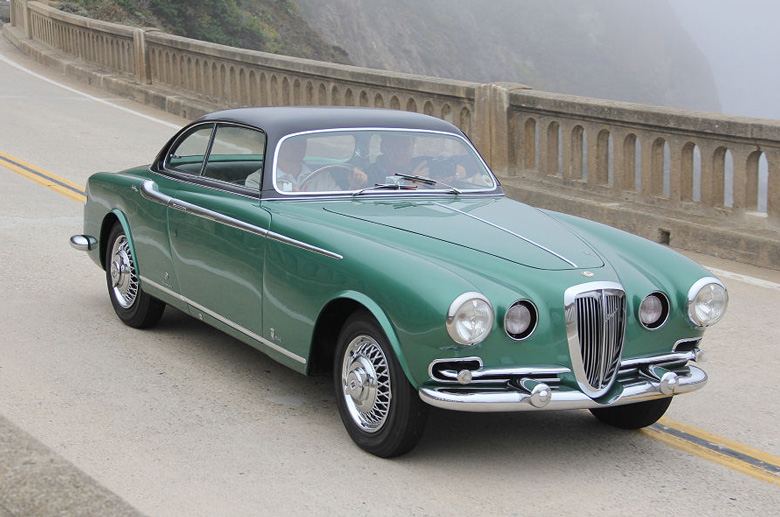
As part of our ongoing series of articles about Italian coachbuilders, Brandes Elitch provides some thoughts about the recent Crossroads Exhibit in Turin. One of the cars in the exhibit is this superb blend of cultures as penned by Giovanni Michelotti on a Lancia B24 chassis. Hugues Vanhoolandt photo.
Story by Brandes Elitch
Photos by Hugues Vanhoolandt and the Nuvolari Museum
Currently, and until June 25th, the National Automobile Museum of Turin (MAUTO) features an exhibit called “Crossroads: Italy – USA Intersections from after the war to the postwar economic boom.” It explores the cross-pollination and cultural themes of American and Italian designers and their work from 1945-1975. It is an important exhibition, and if you are able, do not miss the opportunity to see this remarkable combination of American and Italian styles.
Postwar Italy in ruins
Most Americans are unaware of the immensity of the work involved in rebuilding Italy after WW II. Italy was literally crippled with the legacies of civil war, fascism, the war, and the occupation and devastation inflicted by the Germans. As Historian Dr. Niamh Cullen writes, “Peasant women still spent most of their lives in mourning clothes and donkeys, not cars, were still the accepted mode of transport. The infrastructure of many cities, Rome, Naples, Milan, Turin, Genoa, was nearly destroyed, while poverty and disease dominated life in Naples and the rural south.”* At the same time, and in part due to the effects of the Marshall Plan, Italy looked toward America, both financially and culturally.
MAUTO: The “PF 200” by Pinin Farina, a concept car unveiled at the 1952 Turin motor show, was originally designed as a show car, not intended for the market, a stylistic exercise to capture the attention of the most demanding clientele at motor shows and at elegance competitions. It had a streamlined body evoking the fuselage of the jet fighters of the time, equipped with a huge air intake at front. Of the 3 or 4 roadsters built, the one with chassis number B52 1004 is even more unique on account of its former owner, actor-singer Renato Rascel, who purchased it at the 1952 Turin motor show and drove it for six years at the time of the Dolce Vita. Thanks to PUGLIA AUTO CLASSICA
VT: We tend to think of fighter jets being an American idiom. They were, however, internationally popular and constructed in Great Britain, France, the USSR and U.S.A. The influence here was not uniquely American. ________________________________
Historian Paolo Scrivano adds, “America was becoming Italy’s touchstone. American images loosened and redefined traditional social hierarchies governing Italian society, challenging the old norms of social distinction.” He says that this led to “the individualism of the consumer society, and the privatization of citizenship.”**
With this backdrop in mind, Crossroads Curator Luca Beatrice writes for the Museum, “The second post-war period brought Italy to its knees, starving, wrapped up in grief and ruins. Therefore, there was a need to believe in new heroes and myths to cope with the tricky phase leading to democracy. Journalism, photography, publishing, sports, art, and industry shaped a revolutionary design and style trend. In post-war Italy, the model takes the name of America.”
Seeking cultural models for democracy
While there are 13 great cars to be seen as part of this exhibition, the emphasis is on the cultures that each country cultivated and often shared, presented as a multi-media show. To quote: “The Exhibition is a polyphonic narration spanning from visual arts to advertisement, from literature to cinema, to the search for inspirations that have guided the great car designers between 1945 and 1965.” Worthwhile noting here that it is commonly recognized that the combination of cash and culture from America played a large role in preventing the spread of Communism in Italy.
MAUTO: Designed under the direction of Giovanni Savonuzzi, Cisitalia’s chief engineer from 1945 to 1948, its streamlining fins are barely noticeable on the rear mudguards. The Museum’s exhibit is one of the ten or so that still remain out of the approximately twenty built from 1947 to 1948. Piero Dusio, patron of the Cisitalia, wanted to have Nuvolari on one of his cars mainly for promotional reasons.
VT: Along with the MM coupe and the street version of the Cisitalia 202, Savonuzzi was light years ahead of almost everything else under the drafting board, and the cars were paragons of proportion, proportion, proportion. ________________________________
The first section is called “On the Road vs. La Strada,” contrasting the book by Jack Kerouac and the Italian film as the Italian artists looked at both the Beat Generation and Abstract Expressionism in America. The second section is called “Cinecitta and Hollywood,” showing both the films of the period from Hollywood’s Roman Holiday to the films made in Cinecitta. The third section is called “Divas and Latin Lovers,” in contrast to the California surf scene and the Beach Boys with the Dolce Vita in Rome. Here it’s Marilyn Monroe versus Sophia Loren, Claudia Cardinale, Monica Vitti, and Silvana Mangano.
The fourth section is devoted to the automotive designers. Profiled are Battista Farina, Mario Revelli di Beaumont, Giovanni Savonuzzi, Virgil Exner, and Giovanni Michelotti. Harley Earl is included, although he wasn’t technically a designer, he managed and immense staff of over a thousand designers, stylists, modelers, artists and assorted support staff, rather than actually creating something of his own design. The other men are truly great artists that, like all great artists, created works of striking originality with their own identity.
MAUTO: Purchased by Tazio Nuvolari in 1950, this car still has its original documents with the name of the great champion from Mantua. Fiat assigned its best technicians, headed by engineer Dante Giacosa, to the development of the Fiat 1400, unveiled at the Geneva motor show in March 1950. The car drew its inspiration from the US-styled bodies that were all the vogue at the time: it was characterized by its appreciable, no-nonsense volume. Thanks to AMAMS TAZIO NUVOLARI, MUSEO TAZIO NUVOLARI and ACI Mantova for the use of the photo.
VT: An interesting artifact for the Crossroads exhibition: The 1400 shared a utilitarian, common style with U.S. cars but also French and British saloons. ________________________________
In 1950, Americans dominated product design, but since then it has been the Italians who have done so. Writer Writer Susan Anderson noted, “The development results from a combination of factors: the postwar boom, where design is considered an added selling point in competing with US-dominated markets, a generation of designers who believe that the new age does not have to be sterile, and industrialists who refuse to make ugly products.”
When I wrote the “Lancia Loraymo” book about Raymond Loewy, I found his thoughts on this. “The Italians are more sophisticated with form, detail and color…German design is very Teutonic, harsh; it’s very analyzed – mental design against intuitional design. The Italians stop short of dryness and aridity. American industrialists have historically viewed industrial design as less important than productivity and profits, and perhaps unrelated. Now aesthetic appeal becomes an important selling point.”
MAUTO: In 1951, Lancia produced the B52, a chassis specially designed to be outfitted by coachbuilders; of the 98 chassis produced, 11 were handed over to Vignale who asked Giovanni Michelotti to design the bodies. Michelotti styled cars with highly elaborate, even somewhat excessive, lines, and this B52 was no exception: it featured showy chrome plating, striking bumpers and unique headlights suspended within round air intakes. Thanks to CORRADO LOPRESTO
VT: A great blend of both schools of design? ________________________________
The cars on display are meant to show the best of both post war worlds, and perhaps how each culture influenced each other. The Italian entries are as follows.
-1947 Alfa /Romeo 6C sport cabriolet “extralusso” Stablimenti Farina, 1947
-Cisitalia 202 SMM Spider Nuvolari 1947
-FIAT 8V Demon Rouge 1953
-Lancia Aurelia B52 coupe Vignale 1953
-Lancia Florida Pinin Farina 1954_Lancia Aurelia Pinin Farina PF 200 1952
-FIAT 1400 Nuvolari 1950
The American entries are:
-1937 Packard Super Eight
-1948 Hudson Commodore Six coupe 1948
-1957 Plymouth Fury
-1947 Buick Roadmaster convertible
-1954 Cadillac Sixty Special Fleetwood
-1965 Lincoln Continental 4 door convertible
If one is looking for cross-continent influences in car design, ie, fins, headlights, two tone paint on one side and clean, efficient lines with great proportions on the other, I don’t think the Crossroads Exhibit does this. But it brings up the subject for us to contemplate and comment upon (which is the reason for an exhibition in the first place).
American influences in Italian design
It occurs to me that some facets of American styling were copied by the Italian coachbuilders, but with rare exceptions not the totality of a particular American car, more likely little superficial touches, such as Buick portholes and grilles, two tone paint with chrome accents, taillights, fins (some, but not widespread), Ford grilles and front fenders and lighting position, egg crate grilles, the 46-47 Studebaker, etc. Some were copied more than others, such as the ’36 Ford. Monterosa built a woody wagon on a 1950 FIAT chassis that is an exact copy of an American wagon from the cowl back. And, one cannot just copy the inherent style of a design by making an eight-tenths model in reduced scale, because if you do the design will be compromised. Thus, you cannot transplant a design from a 16 foot American car on a small FIAT chassis.
MAUTO: At the 1955 Paris motor show, Pinin Farina presented its first Lancia Florida prototype, whose innovative style, with its straight and squarish lines, would influence car design for a decade. The car displayed in Paris was a two-door sedan built on an Aurelia chassis, but later in the year, a more elegant version went on display at the Turin and Geneva motor shows. Featuring four doors, it would then evolve into the Lancia Flaminia, the successor of the Aurelia. Three examples were built of this four-door Florida. Of these three cars, two were right hand drive models, whereas the one on display here, mounted on a 1006S chassis, was the only one with left-hand drive. Thanks to CORRADO LOPRESTO
VT: Suddenly it’s 1960 and Pinin Farina has changed the game of car design. ________________________________
And vice-versa
And the same is true for American stylists. With the exception of the ’52 Nash, in which Pinin Farina had a hand, and perhaps the little Rambler with the fold down convertible roof, there is very little Italian influence until you get to the Bill Mitchell period at GM, where Mitchell copied certain details of the iconic Lancia Flaminia hardtop for the Buick Riviera and Pontiac Grand Prix. But there was no trace of Italian influence in Earl’s bloated or comic entries, such as the B-58 Buick or the Firebird dream cars – these were inspired by Buck Rogers, not Torino. Remember too, that the Big Three had their own captive brands in Germany (Taunus, Opel), England (Vauxhall, English Ford), France (SIMCA), and Australia (Holden). Yes, those brands reflected American styling, because these cars were styled in the US, or done by transplanted Americans. Of course they looked like American cars.
When you look at the great designers of the postwar period, it is surprising that for a country the size of Italy, Italian names dominate: Giovanni Michelotti, Franco Scaglione, Batista Pinin Farina, Marcelo Gandini, and Giorgetto Giugiaro. We Americans have Exner. The British have Malcom Sayer and Ian Callum.
MAUTO: The Lincoln Continental of the sixties is considered another icon among American historic cars. Although its fame is sadly linked to the assassination of President John Fitzgerald Kennedy, the unusual four door (nicknamed suicide door) Lincoln Convertible is indisputably a cult car. Thanks to NICOLA BULGARI
VT: Was Lincoln influenced by the Pinin Farina Lancia Florida? If so, how. You tell us. ________________________________
There was however one American design which did in fact catch on in Europe: the Corvair sedan. The Corvair was first shown at the 1959 Paris Motor Show, and European designers were paying attention to its horizontal beltline, flat trunk and flat hood and “flying wing” rear window and flat-top roof designed by Carl Renner and Ned Nickles. Shortly thereafter, the design influence was felt in France, England, Germany, Italy, and even Japan (a 1963 Mazda Familia designed by Giugiaro at Bertone). But other designs that we think of as iconic, such as the 53 Studebaker Starlight coupe designed by Bob Bourke, and the 61 Lincoln designed by Elwood Engel, and even the fabulous Forward Look designs of Virgil Exner, were not copied in Italy.
Finally, I would like to say a word about the unsung hero of this exhibition: Nicola Bulgari, yes that Bulgari of the fashion and jewelry empire. Bulgari loaned some of the cars to the exhibition, but more importantly, particularly to American readers, he is establishing a world class car museum complex in Allentown, Pennsylvania that will make Allentown a national center of automotive restoration excellence, attracting collectors from all over the country. Bulgari runs a restoration facility there and a museum which houses 150 cars (he keeps another 60 in Rome). His focus is Buick, which is perfectly understandable, as you could have a world class collection of cars which were only Buicks.
* Dr. Niamh Cullen was an Irish Research Council Marie Curie research fellow at University College Dublin where she also taught modern Italian and European history. and also a visiting fellow at the University of Milan from 2011 to 2013 until joining the staff at the University of Southampton, UK.
** Paolo Scrivano, Building Transatlantic Italy: Architectural Dialogues with Postwar America . (Ashgate Studies in Architecture Series.) Burlington, Vt.: Ashgate Publishing Co.
Please note that we have not seen the exhibit in person, and that the photos of the six cars above and below are not photographed at the Museum itself.

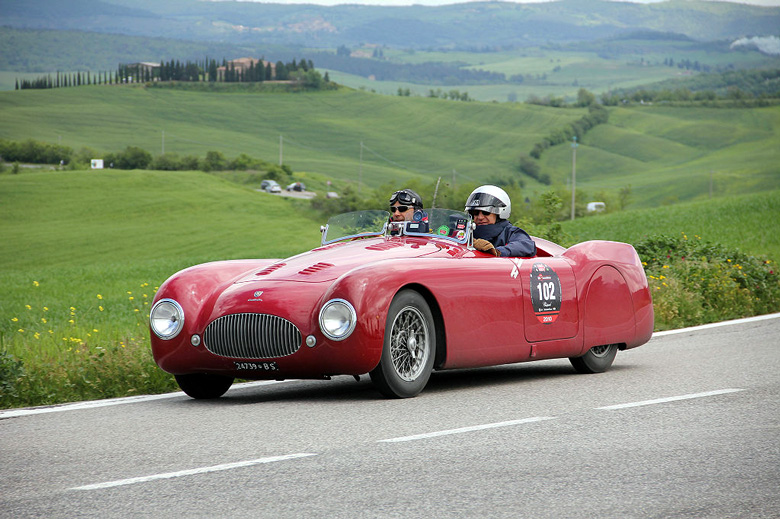
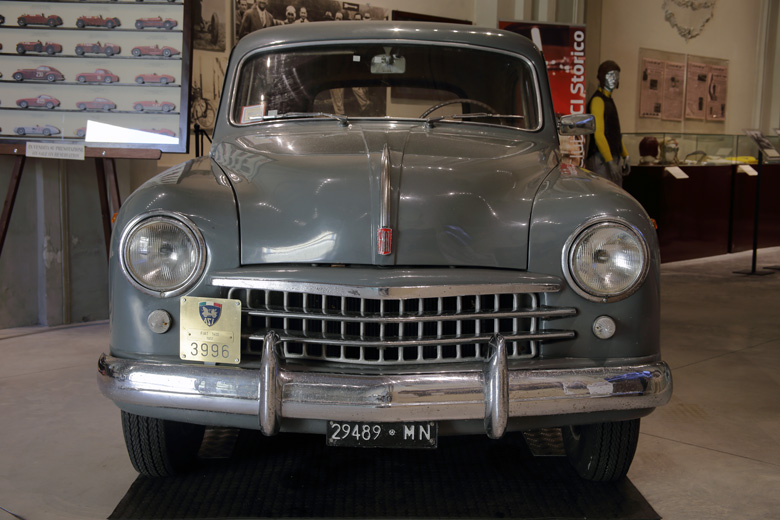
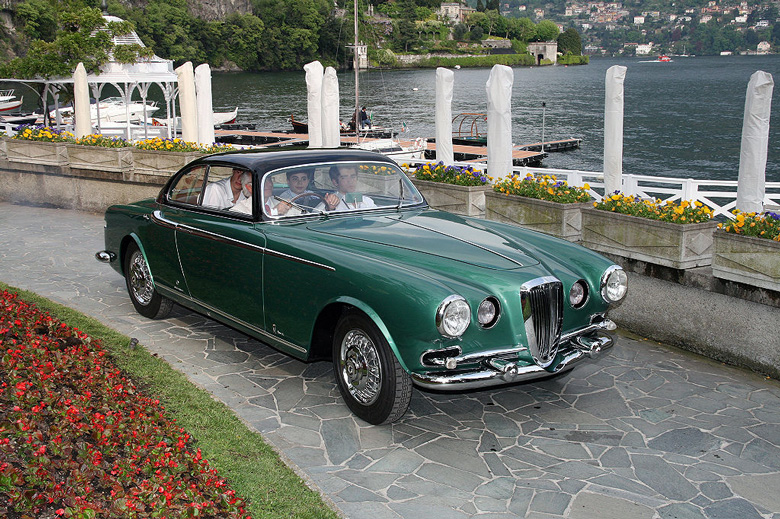
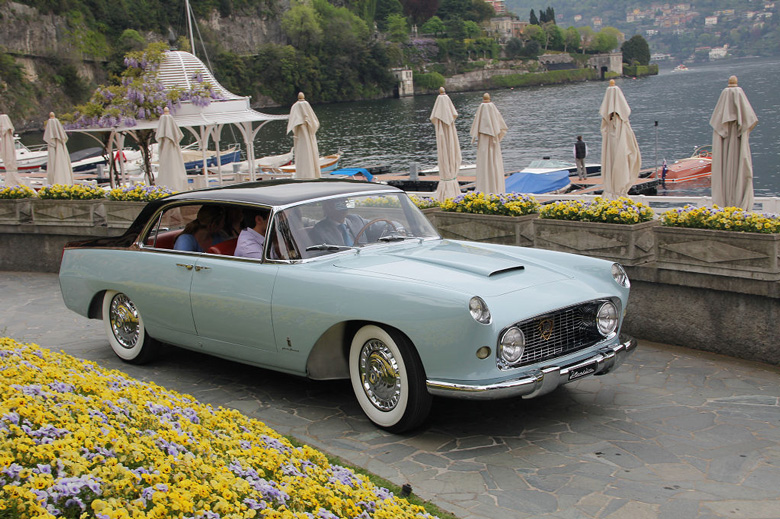

So many times, we read that this designer copied that designer’s design, which is frustrating to me as a designer (stylist, if you will) with a lifetime career in automotive styling. Designers do not routinely go about their tasks copying others designs. All designers are products of their surroundings mixed with their own creativity in order to complete any given project. It would therefore be far more accurate to say a design had been INFLUENCED by a preceding one. This would also indicate the proper respect that the profession deserves. Dave Cummins, Tucson, Arizona